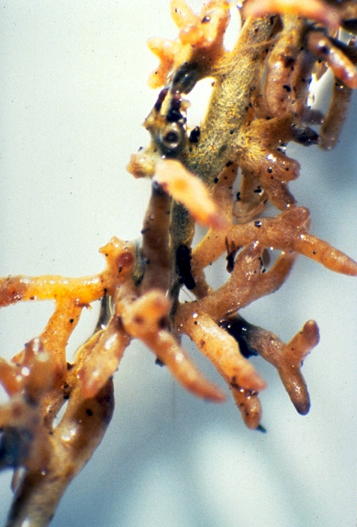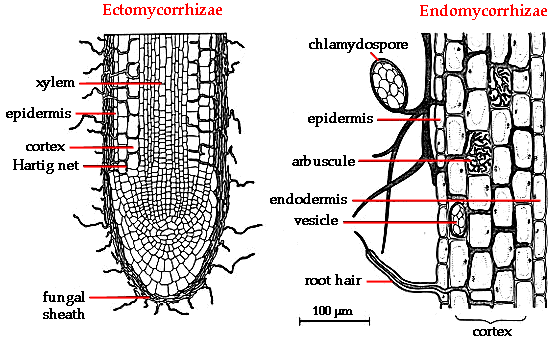 Mycorrhizae are Friendly Fungi - July 26, 2006 Jeff Schalau, County Director, Associate Agent, Agriculture & Natural Resources Arizona Cooperative Extension, Yavapai County Imagine a fungus that wraps around the roots of practically every plant in the landscape and uses the some of the plant's energy to sustain its cellular metabolic needs. This fungus is everywhere. In fact, they are probably lurking under the soil in your back yard right now. No, this is not some scary story designed to raise the hair on the back of your neck during the appropriate season, it's real...it's mycorrhizae.  Mycorrhizae (pronounced mi-cor-ri-zay) have a mutualistic relationship with the green plants that they colonize. In other words, both the fungus and the plant benefit from the association. In general, mycorrhizae assist the plant by improving water and mineral nutrient uptake. Tiny fungal strands called mycelia can grow through soil much faster and more easily than plant roots and can therefore utilize a much larger soil volume in search of these resources. In return, the plant provides carbohydrates (sugars) to the mycorrhizal fungus. Mycorrhizae (pronounced mi-cor-ri-zay) have a mutualistic relationship with the green plants that they colonize. In other words, both the fungus and the plant benefit from the association. In general, mycorrhizae assist the plant by improving water and mineral nutrient uptake. Tiny fungal strands called mycelia can grow through soil much faster and more easily than plant roots and can therefore utilize a much larger soil volume in search of these resources. In return, the plant provides carbohydrates (sugars) to the mycorrhizal fungus.About 80% of higher plants found in nature and all gymnosperms (cone bearing plants) can be colonized by mycorrhizae. There are two major classifications of mycorrhizae: ectomycorrhizae and endomycorrhizae. As the names imply, ectomycorrhiza refers to a fungus growing outside plant root cells. Endomycorrhiza refers to a fungus that penetrates plant root cells. Another name for endomycorrhizae is arbuscular mycorrhizae. Soil inoculants that include various species of mycorrhizae are grown commercially and available for purchase. The inoculum can be introduced to young plants during nursery production or applied to the soil prior to planting. There are certainly biological benefits to inoculation, but the jury is still out on the economic returns of doing so. One of the biological benefits is protection of plant roots from root rot fungi. The mycorrhizae occupy a niche that could otherwise be occupied by a disease causing pathogen. Mycorrhizae can also improve phosphorus uptake by the crop plant where phosphorus availability is low. So why do mycorrhizae exist? To make life easier for plants...probably not. They probably responded to environmental changes over time that allowed them to make a decent living by coexisting with plants. Scientists study the interrelationship between mycorrhizae and host plants and have learned that some mycorrhizae border on being parasitic, but provide just enough benefits to the host plant to keep it alive. Other research has shown that as a plant community matures and species present go through succession processes, the mycorrhizal species change too. In native plant communities, mycorrhizal populations have coevolved with plants species. Relatively undisturbed sites with native plant communities present or nearby would likely have functional mycorrhizal populations that could colonize roots of newly planted natives. Conversely, non-native plants planted on these sites may or may not form associations with local mycorrhizal species. Understanding of plant-mycorrhizal relationships and commercial use of mycorrhizal inoculants have increased in recent years. A common mycorrhizal application is in mine reclamation where soils have been drastically altered or disturbed. The nursery and green industries are also embracing mycorrhizae. One study looked at the effects of four commercially available mycorrhizal inoculants on liquidambar trees. That study found that two of the products increased leaf area, plant dry weight, and growth rate. While the other two other products colonized the plant roots, there was no difference in plant growth when compared to the control (no treatment). These results serve to demonstrate there is variability among various mycorrhizal products. There is also variability between plant species, soil media, cultural methods, etc. Aside from benefiting plants, some mycorrhizal fungi produce delicious edible mushrooms such as chanterelles, boletus, matsutakes, and morels. As you may imagine, mycorrhizal mushroom production is difficult to manage because it requires an entire ecosystem to produce them. Here, researchers are investigating forest management practices that produce both timber and wild edible mushrooms. The University of Arizona Cooperative Extension has publications and information on gardening and pest control. If you have other gardening questions, call the Master Gardener line in the Cottonwood office at 646-9113 ext. 14 or E-mail us at cottonwoodmg@yahoo.com and be sure to include your address and phone number. Find past Backyard Gardener columns or submit column ideas at the Backyard Gardener web site: http://cals.arizona.edu/yavapai/anr/hort/byg/. |